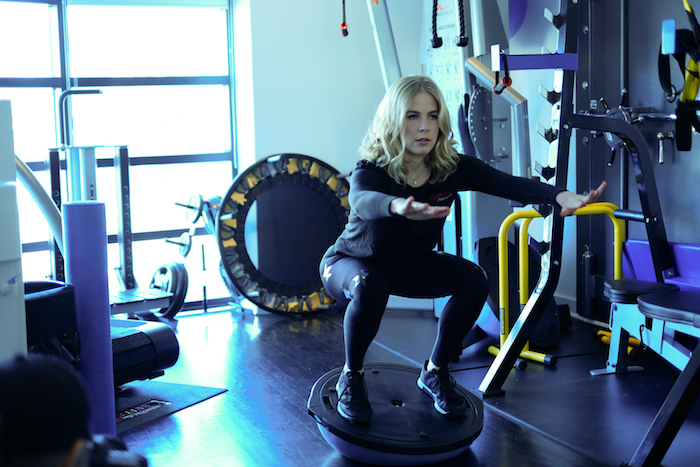
By Kathleen Trotter
Running is a convenient, exhilarating, and effective workout. The problem is, running is also hard on the body — every time the foot hits the ground, the body has to dissipate up to six times your body weight. The benefits of any workouts are short lived — if not completely moot — if the activity results in injury; nothing derails training motivation and compliance like an injury.
Hence my favorite tagline: “Get in shape to run; don’t run to get in shape!”
Too many of us use running to get in shape when, really, we need to properly prep our bodies to run. We need to prioritize gradual progression, strength training, and appropriate recovery.
Gradual Progression
Slowly build time and distance — after a winter of not running, don’t just go out and run 5 miles. If you have taken a running hiatus, consider starting with shorter running intervals, maybe 5 sets of 4 minutes. If you are an absolute newbie, start with 5-10 sets of 1 minute of running and 2 minutes of walking.

Strength Training
Think hips and glutes, the lower leg (feet, calves, and shins), core, and single-leg exercises.
Strong glutes and a stable core stabilize the ankles, knees, and hips and dissipate ground reaction forces. Exercises that strengthen the lower leg promote power through the ankles and hips, and protect against injuries such as shin splints and plantar fasciitis. Since running is a single-leg activity, exercises that require the entire body to balance on one leg are extremely sport specific.
Sample circuit: 10 lunges on right leg, 10 single-leg calf raises on right leg, 30 seconds balancing on right leg, 10 single-leg bridges on right leg, 30 seconds front plank. Repeat the entire circuit on the left leg.
Lunges: Step backward with left leg. Bend both knees so you move toward the floor. Use the bum muscle of the right leg to stand up.
Calf raises: Hook your left foot around your right ankle. Keep your weight equally distributed between the ball of your big toe and your little toe as you rise up onto your toes. Core engaged. Chest out. To regress this exercise, try resting your left toes gently in a “kickstand” behind you — 95% of your weight on your right leg.
Single-leg balance: Bring your left knee up to hip height. Use your right bum muscle to stabilize your body. Try not to roll in or out on your right foot. Chest out. Core engaged.
Bridges: Lie on your back. Knees bent. Feet hip-distance apart. Lift your hips from your bum. Don’t let your feet roll in or out. Engage your core so you don’t arch your lower back. Hold up. Lift your left leg. Pelvis level, right bum engaged.
Plank: Balance on your forearms and knees or toes. Lower back neutral. Activate the muscles around your armpits and in your core to stabilize. Breathe. Start from your knees. If there’s no negative pain in your back, progress to balancing on your toes.

Recovery and Cross-training
Exercise is only a positive stress if you give your body the tools and time needed to recover. Stay hydrated, stretch, sleep, take adequate rest days, and fuel with nutritiously dense non-processed foods.
One of my favorite recovery tools is the foam roller. Try melting your calf tightness with calf foam rolling. Sit on the floor with the roller under your calves, perpendicular to your body. Lift your bum slightly off the ground. Roll yourself forward and backward so the roller moves up and down your lower legs. Experiment. Rotate your legs side to side slightly as you move. Pinpoint a few trigger points.
Main take-away
Running is a fantastic workout, as long as your body is strong enough to dissipate the forces. Your entire lower kinetic chain has to be strong enough to support continuous single-leg impact forces far greater than just the weight of your body. If your kinetic chain is not strong enough and/or you don’t give yourself enough recovery time between runs, injuries occur.
This advice is not just for runners. It holds for any activity you have not done for an extended period of time. Have not been walking all winter? Don’t just go out for a two-hour walk. Build up. Haven’t been playing basketball? Build up. Give your body time to adapt. Strengthen the movement patterns you need for your sport.
Kathleen Trotter (MSc) is a fitness expert, nutrition and life coach, media personality and author of two books including her most recent Your Fittest Future Self. Connect with her on social media at FitByKathleenT or through her website KathleenTrotter.com
The Editorial Team at Lake Oconee Health is made up of skilled health and wellness writers and experts, led by Daniel Casciato who has over 25 years of experience in healthcare writing. Since 1998, we have produced compelling and informative content for numerous publications, establishing ourselves as a trusted resource for health and wellness information. We aim to provide our readers with valuable insights and guidance to help them lead healthier and happier lives.

































1 thought on “Don’t Run to Get in Shape…Get in Shape to Run!”
Comments are closed.